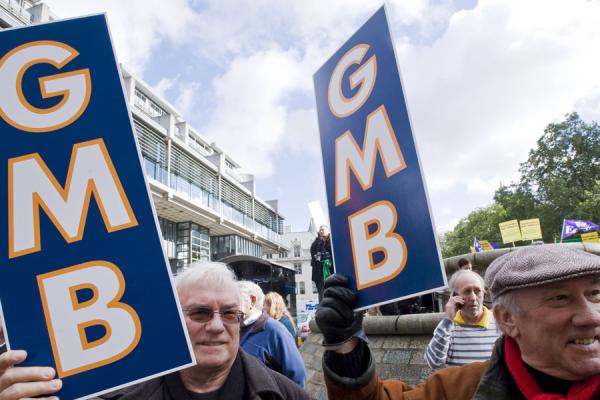Average rents for a 2 bed property in South East England increase 25% since 2011

Average rents for a 2 bedroom property increased by 25% since 2011 in the South East new GMB study shows.
Pay has to rise to allow workers to afford these ever rising rents so the public sector pay cap and the below inflation pay rises in both the public and private sectors has to end to avoid a drop in consumer spending, which, if not checked will lead to a further recession says GMB Southern region.
The average rents for two bedroom apartments in Dartford has risen from £650 per month in 2011 to £900 in 2017, an increase of 38.5%. This is the highest increase in 67 local areas in South East England.
Next in the league for the increase in the average rents for two bedroom property between 2011 and 2017 is Reigate and Banstead at 32.7%, followed by Wycombe at 32.7%, Epsom and Ewell at 31.6%, Tandridge at 29.4% and Chiltern at 29.4%.
As a result of these increases the average rents for two bedroom apartments has now risen to more than a third of gross average earnings of residents in 36 South East local authorities.
These are Oxford, Runnymede, Brighton and Hove, Epsom and Ewell, Guildford, Adur, Slough, Sevenoaks, Reigate and Banstead, Woking, Spelthorne, Crawley, Tunbridge Wells, Tandridge, Reading, Windsor and Maidenhead, Elmbridge, Wycombe, Bracknell Forest, South Bucks, Rushmoor, Chiltern, Canterbury, Eastbourne, Southampton, Lewes, Worthing, Milton Keynes, Arun, West Oxfordshire, Chichester, Dartford, Mid Sussex, Maidstone, Portsmouth and Havant.
In Oxford the average rent for a two bedroom property is 46.3% of the gross average earnings of residents of the borough. This is the highest in the South East.
Next highest are 46% in Runnymede, 45.5% in Brighton and Hove, 43.3% in Epsom and Ewell, 43% in Guildford, 42.5% in Adur and 41.4% in Slough.
In the South East as a whole, workers are paying out 34.1% of their earnings on rent, up from 28.7% in 2011. This is significantly higher than the England average figure of 27.4%.
Set out in the table below are the 2017 figures for 65 local authorities where data are available with comparable figures for 2011 for a two bedroom property.
The tables have been compiled by GMB Southern region, see notes to editors for sources and definitions.
Paul Maloney, GMB Southern regional secretary, said,
“These figures demonstrate the extent of the squeeze felt by workers and their families in the South of England since the financial crisis in 2008. Rents have surged upwards as pay has been stagnant or falling.
Pay has to rise to allow workers to afford these ever rising rents so the public sector pay cap and the below inflation pay rises in both the public and private sectors has to end to avoid a drop in consumer spending, which, if not checked will lead to a further recession.
In addition, they show that a massive programme to build more homes, especially homes for rent, by the South of England authorities is absolutely essential in all parts of the region and has to get underway without delay.
We have been talking about this problem for far too long, there can be no excuses for not providing housing to people that they can afford to live in on average wages.
The decisions of the Thatcher government in the 1980’s to sell council housing stock, and not replace it, and to pay landlords housing benefit instead of providing social housing directly has been a huge and expensive mistake.
Last year, for example, £24 billion was spent on housing benefit, with much of this public money ending up untaxed in bank accounts in offshore tax havens. If a fraction of that amount had been spent on social housing for rent, the strain on the tax payer would be less and people would have housing they can afford to live in.
These mistakes need to be corrected without delay, fair and affordable housing is a basic aspiration for all.”
ENDS
Contact: Paul Maloney on 07801 343839; Michelle Gordon on 07866 369259; 0208 457 4143
Notes to Editors
1 Source: Private Rental Market Summary Statistics; Valuation Office Agency © Crown copyright 2017.
The data is collected by the Valuation Office for the purpose of supporting the Local Housing Allowance – used to work out how much Housing Benefit is paid if renting from a private landlord. This is the primary purpose of the data and as a result the samples from year to year can vary so the data provides a snapshot on the market rather than a comprehensive study of all prices. The data used to generate these statistics are based on a sample of rental information, collected by Rent Officers from landlords and letting agents.
Two Bedroom self-contained properties including houses, bungalows, flats and maisonettes.
2011 data is for the 12 months to the end of June 2011
2017 data is for the 12 months to the end of March 2017
2 Earnings data is from the Annual Survey of Hours and Earnings 2011 and 2016, Office for National Statistics. Data is for gross median annual pay for all full time employees by place of residence.
For more information, please visit www.gmb-southern.org.uk. | To unsubscribe, click here.



